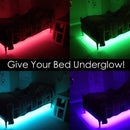Introduction: Secret Light Bulb Hiding Place
Do you have any burnt out incandescent bulbs? Don't throw them out! Instead, why not turn them into super secret hiding places? Depending on the size of the bulb, these can be used for storing secret printed messages or passwords, small jewelry, paper money, or anything else that can fit through the hole. Then just screw the bulb into a socket and nobody will ever know there's something inside. This Instructable will detail the steps involved in preparing the bulb to be used as a secret safe.
I came up with this idea after seeing an Instructable on how to make a light bulb oil lamp. I thought it was a neat use for a seemingly useless object. I thought "what if, instead of using it for an oil lamp, you hid stuff in it?" I did some research on how to safely open a light bulb and I figured out the best way to do it, and I also figured out how to make it more discreet. The best part is this project is absolutely free!
Keep in mind that this project involves spray painting, as well as breaking glass (in a controlled fashion) so safety glasses are very important.
Step 1: Tools and Materials
You will need the following tools:
Needle nose pliers
Steel wool
Wooden vise
Hammer
Chisel or standard screwdriver
Frosted Spray Paint For Glass
Safety goggles are absolutely necessary!
You also need a workspace that can get slightly messy, and make sure the floor is able to be swept. Don't do this over carpet!
The lightbulb you use must be incandescent and large. If it is too small, like a night light bulb, the opening will be too small. Try it if you want, but you will only be able to fit paper inside. Also, it does NOT need to have a frosted white finish. That will come off anyway, but this Instructable takes care of that. Also, make sure the bulb is indeed burnt out first. Don't be like me and accidentally waste a perfectly good bulb...
Step 2: Removing the End
The reason you need a wooden vise is that a metal vice will likely crack the bulb. Trying to complete this project without a vise (just holding the bulb) will be challenging and dangerous.
First put the bulb into your wooden vice so it grips the metal base. Then use your soldering iron to heat up the lump of solder from the end of the bulb and use pliers to scrape the liquid solder from around the edges. If you have a desoldering iron, use it. I don't, so I'm writing this the way I personally did it. Your bulb might not have solder on the end, but 99% of the ones I've seen do.
Then take the needle nose pliers and pry off he end cap. There is a black ceramic ring around the cap. You want to leave that now and just remove the small metal disk from the end.
Step 3: Removing the Black Ring
This step must be done carefully, if you aren't careful you can ruin the threads on the metal base and the bulb won't be able to screw into a socket.
Grab a standard screwdriver or a small chisel (I used both) and a hammer, and gently pry from below the black ceramic ring. Don't worry about the ring, it can be damaged. Worry about the threads on the metal base. Once you have a small gap between the bottom of the black ring and the metal below, aim the screwdriver up into the gap and hit it with a hammer. It should be struck in an upward direction to cause the metal ring to chip off and fly upwards. If you try hitting it down, the vise will just keep absorbing the impact until you slowly inched the bulb all the way down and out of the vise.
Once the first chip of ceramic flies off, use pliers and a chisel (or screwdriver) to break away the rest of the ceramic ring. Don't worry about pieces falling into the bulb.
Important: You will probably find a strange brown edge on the inside of the bulb (shown in my photo). Do not try to break this off, it's too strong. I tried to remove this in order to widen the space to put things in. It wouldn't break at all and the bulb felt like it was going to smash if I hit it any harder. Just leave it.
Step 4: Open the Glass Bulb
You will now see a long, thin glass tube with two wires coming out. In order to put things in the bulb, we need to break this open to reveal the large room inside the bulb. Doing this will break the seal and release the gasses inside. Don't worry though, it's mostly argon which isn't harmful. Contrary to popular belief, there isn't a vacuum inside so the bulb won't implode when we break the seal.
Grab a small metal rod, small screwdriver, or a chisel, and a hammer. Position the metal object of choice so it sticks into the end of the bulb near the bottom, basically just as far down as it will go. Then hit the end of the metal object with a hammer. You want to hit it with as little force as possible, just enough to break it. Tap gently first and slowly increase the force. If you smash too hard, the metal tool could break right through and break the actual bulb, which we want to use. Once it has broken, carefully chip away the rough edges sticking out.
Now use needle nose pliers to extract any large pieces, such as the long glass tube with the wires. Then shake the bulb upside down over a garbage can to get every last particle out. You may want to use water or compressed air.
Step 5: Finishing Touches
By now, you will probably notice large marks in the white powder lining the inside of the bulb. It's basically impossible to avoid wrecking the white powder. So I decided to remove it all together and put my own finish on it.
To remove the white material, you can try filling the bulb with water and sloshing it around. This got most of it out for me, but not the stuff near the neck of the bulb. For this, take the steel wool and pull it into a long strand. Using a screwdriver or any long metal object, start pushing the steel wool into the bulb. Shove in as much steel wool as you can but be sure to leave a bit sticking out. Now grip what's left sticking out with pliers, and start twisting and spinning it around until all the white powder has been scoured off. Then carefully pull all the steel wool out of the bulb. You can blow most of the powder off the steel wool and use it again for another project. Obviously don't use it near food anymore, like cleaning pots. Now to get all the loose powder out of the bulb, fill it with water and dump it out a few times.
Now you should have a clear bulb. In its current state, it is useless for hiding things in since they would be totally visible. Now place the bulb in a portable vise, or stand it up on its end outside. Using the frosted paint, spray an even coat around the entire bulb. After about 15 minutes, do another coat. Try to keep paint off the metal base, this will only make it harder to screw into a socket. A few drops won't make a difference. Depending on the paint, you may need a different number of coats. I did about 4 to make it translucent enough. You will want it to be translucent enough to hide things, but not so much paint that it looks grey.
Alternatively you could use a high gloss white spray paint if the frosted look isn't realistic enough for you. For me, it blocked out enough light to prevent you from seeing what's inside.
Now you're done! Once the paint dries, screw it into a socket in a lamp and hide things! Obviously the bulb won't be able emit light, but if you want you can design some sort of Led device that can fit into the bulb and make the secret bulb even more sneaky. I didn't do this because I wanted maximum room inside the bulb. If you wanted, you could make a tiny LED Throwie and stick it in the bulb. You just won't be able to turn it on and off with the ordinary switch for the bulb.

Participated in the
Makerlympics Contest

Participated in the
Secret Doors and Compartments Contest












